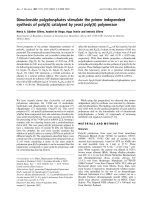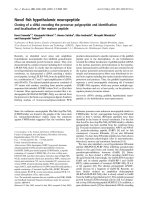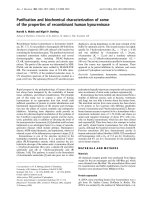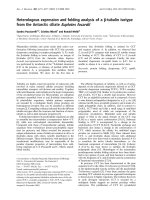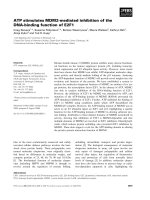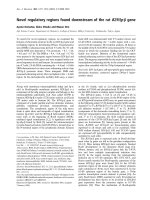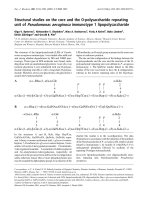Báo cáo y học: "“I could cry, the amount of shoes I can’t get into": A qualitative exploration of the factors that influence retail footwear selection in women with rheumatoid arthritis" pdf
Bạn đang xem bản rút gọn của tài liệu. Xem và tải ngay bản đầy đủ của tài liệu tại đây (252.84 KB, 8 trang )
RESEARCH Open Access
“I could cry, the amount of shoes I can’t get into":
A qualitative exploration of the factors that
influence retail footwear selection in women with
rheumatoid arthritis
Serena Naidoo
†
, Stephanie Anderson
†
, Joanna Mills
†
, Stephanie Parsons
†
, Stephanie Breeden
†
, Emma Bevan
†
,
Camilla Edwards
†
and Simon Otter
*
Abstract
Background: Studies have reported that women with rheumatoid arthritis (RA) are not wearing NHS supplied
therapeutic footwear; therefore it is likely they are wearing footwear sourced through retailers. Previous research
gives limited informa tion (largely associat ed with cosmesis) on people’s perceptions on the relationships that exist
between retail footwear, well-being and quality of life. This study aimed to explore the perceptions of women with
RA regarding their choice of retail foot wear and identify the factors influencing retail footwear selection.
Methods: Eleven women wi th RA wearing normal retail footwear were recruited from an out-patient podiatry
clinic in the south east of England. Semi-structured interviews were carried out and an interpretative
phenomenological approach was adopted for dat a collection and transcript analysis.
Results: Six key themes were revealed from the analysis: (1) the natu re of foot complaints and deformities, (2)
aesthetic appearance and design of footwear, (3) body image, (4) psychosocial aspects, (5) Perceptions of footwear
and (6) the therapeutic value of retail shoes. These contributed to an overarching concept of loss of choice
associated with retail footwear. In particular, the areas discussed most frequently throughout were themes (2), (3)
and (4), which were notably more ‘emotional’ in nature.
Conclusions: Limitations in retail footwear for these women have impacted on their individuality, linking
significantly with their body image. The loss of choice in footwear as a consequence of the disease impacts
negatively on em otions, wellbeing and was identified in reduced self-perceived quality of life.
Background
Rheumatoid arthritis (RA) is a syst emic, symmetrical
inflammatory disease typically affecting several joints in
the hands and feet [1]. This autoimmune disease causes
synovial infl ammatio n and destructi on of joint architec-
ture, leading to pain, loss of joint function, muscle atro-
phy from disuse and inability to participate in work and
social activities [1-4]. These factors are often associated
with disability and poor or reduced health-r elated qual-
ity of life [5,6]. The irreversible destructive changes
within the foot often cause visible cha nges in foot struc-
ture, causing difficulty in finding safe and comfortable
retail footwear [2,7]. A poorly fitting shoe may exacer-
bate foot complaints, induce further damage or cause
falls due to reduced proprioceptive capacity, balance and
postural reactions [8,9]. The impact of poorly fitting
footwear may be under-estimated; indeed Williams and
Bowden [10] reported that only 51% of people with
rheumatic diseases were wearing suitable retail footwear.
Those with inadequate footwear reported that their
shoes contributed to or exacerbated their foot problems.
It is reported that the aims of foot care for patients
with RA are to decrease pain, increase mobility and
enhance quality of life [11,12]. However, achieving these
* Correspondence:
† Contributed equally
School of Health Professions, University of Brighton, Robert Dodd Building,
49 Darley Road, Eastbourne, BN20 7UR UK
Naidoo et al. Journal of Foot and Ankle Research 2011, 4:21
/>JOURNAL OF FOOT
AND ANKLE RESEARCH
© 2011 Naidoo et al; licensee BioMed C entral L td. This is an Open Access article distributed under the terms of the Creative Co mmons
Attribu tion License ( ), which permits unrestricted use, distribution, and reproduction in
any medium, provided the origina l work is properly cited.
aims can be difficult as those with RA often re port fr us-
tration with everyday footwear citing difficulties with
availability and choice [13], making goals associated
with increasing activity unlikely, causing further emo-
tional distress [14]. Many people with RA are prescribed
therapeutic footwear but do not wear them, often due
to poor fit or unacceptable cosmesis [15,16]; suggesting
that the majority are therefore wearing retail footwear
instead. However, the perception of
retail footwear by
people with RA has received little attention in the litera-
ture [17]. Furthermore, there is limited information con-
cerning the rel ationships between f ootwear, well-being
and quality of life (QOL). This study aimed to explore
the perceptions of women with RA on their choice of
footwear and identify the factors influencing footwear
selection from within the retail sector.
Methods
Study Design
A modified interpretative phenomenological approach
(IPA) w as adopted whereby semi-structured interviews
were used to explore a series of in-depth personal
experiences of footwear by women with RA [18,19].
This type of focussed interview approach described by
Merton et al [20] allows for a relaxed style but typically
follows a set of questions derived from a protocol [21].
IPA is a philosophic al approach, which acknowledges
that the researcher applies interpretation to the data and
that is influenced by the researchers’ stance (clinician,
woman, footwear wearer). This approach enabled
researchers to focus on the exploration of participants’
experiences, understandings, perceptions and views
[22,23], in this case associated with retail footwear.
Participants and Setting
The Univ ersity of Brighton School Research Ethics and
Governance Panel granted ethical approval. Potential
participants were recruited from an out-patient podiatry
clinic within the south east of England. Subjects were
invited to participate on the basis that they met the cri-
teria o utlined in Table 1, established through reviewing
their clinical records. Of the 11 women who were
invited to participate, 8 agreed. One declined due to an
impending planned hospital admission, another declined
as her sy mptoms were in a state of flare at the time and
the third declined as she was on holiday. All subjects
provided informed written consent prior to participat-
ing. As an idiographic method, small sample sizes are
considered normal in IPA [24,25].
Developmental Phase of the Study
Prior to undertaking this study all researchers were final
year podiatry students who had participated in the same
training in interview techniques. More than one inter-
viewer was involved in generating data. This modified
approach to IPA limited the potential risk of individual
interviewers’ epistemological perspective impacting on
the research. Given that several resea rchers (SN, SA, SP,
SB, JM, EB, CE) were to condu ct at lea st one interview;
the interview schedule (including how questions were
asked) was jointly developed by the research team and
based o n findings from reviewing the literature ar ound
footwear provision. The key areas to explore included:
footwear selection, footwear design and lifestyle choices.
Interview questions were open-ended to allow for the
introduction of new topics and the interview style was
non-directive where possible [23]. The q uestions were
tested on one individual in a developmental phase of
the study to ensure this semi-structured protocol had
face validity and generated data that met the aims of the
study. Following the initial interview, the interview sche-
dule was further refined (Additional file 1).
Generation of data
Each interview took place within the out-patient clinic
from which participants were recruited; a familiar set-
ting for these individuals. The room used for interview-
ing differed from where treatment would normally
occur to reduce patient anxiety, which may have
affected verbal productivity [26]. No third parties were
present during the interviews. Each interview lasted
approximately one hour and light refreshments w ere
served to participants. Informal conversat ion occurred
before the commencement of interviews to put the par-
ticipants at ease. All interviews were recorded; corre-
sponding with the modified approach to IPA used in
this study [27] (Additional file 2). Follo wing an opening
question enquiring generally about each subjects arthri-
tis, questions and pro mpts were used to facilitate disclo-
sure, maintain conti nuous conversation and to steer the
Table 1 Inclusion Criteria
Female patients with a diagnosis of RA with the absence of additional systemic diseases such as diabetes, where therapeutic footwear may be
required.
Age 18 or over
Able to converse fluently in English
Patients not prescribed or wearing therapeutic footwear e.g. orthopaedic shoes.
Naidoo et al. Journal of Foot and Ankle Research 2011, 4:21
/>Page 2 of 8
participant back to the topics being discussed [19],
enabling and facilitating the discussion between partici-
pant and interviewer.
Data Analysis
Each interviewer transcribed their interview verbatim;
pseudonyms were used to replace the names of partici-
pants both to ensure confidentiality while mai ntaining
personality for each participant. The transcripts were
distributed amongst the researchers to share the data
collected; thus each interviewer read all seven tran-
scribed interviews. Each transcript was read a number
of times by each interviewer to identify recurring
themes. These themes formed the basis of the results
and corresponds with steps two and three of IPA [27]
(Additional file 2). Themes were selected according to
two criteria (i) prevalence of descriptions during the
interviews and (ii) the articulacy and manner in which
‘themes’ assisted the participants’ explanations [28].
This approach to analysis allowed for individual assess-
ment of interpretation with minimal reflexivity; limit-
ing the way person al experiences of researchers could
influence data ana lysis [23,29]. To further ensure cred-
ibility and trustworthiness of data analysis, themes
were discussed amongst the research group as a whole;
creating a joint thematic framework for e ach interview
[23] and therefo re completing the final stag e of IPA
[27,30,31].
Results
Demographic details of participants are outlined in
Table 2 illustrating a varied range of participants each
with different ages, lifestyles and duration of disease
activity reflecting heterogeneity of those with RA. Six
reoccurring themes were identified:
• the nature of foot complaints and deformities,
• body image and footwear,
• psychosocial aspects regarding RA and footwear,
• aesthetic appearance and design of footwear,
• the therapeutic value of retail shoes,
• perceptions of footwear.
With each theme, interview extracts have been
selected as exemplars to represent the most expressive
articulation of the corresponding theme [23].
1. The Nature of Foot Complaints and Foot Deformities
Physical foot deformities resulting from RA were
reported by six interviewees. Notably, it was identified
that the width of their feet ha d increased producing dif-
ficulties when trying to select retail footwear. Two
respondents discussed their concerns with balance and
falls due to their foot changes and having to wear larger
shoes to accommodate deformities. Additionally, struc-
tural changes (e.g. b unions reported in two interviews)
negatively impacted on footwear choice, which was
described as ‘limited’ throughout. This also links with
later results on the way in which women view their own
feet because of these deformities.
“You can see the shape of the joints and everything
through the other side and that puts me off I buy
things that are one size too big so that your feet are
comfortable.” Ivy, 64 years old, a volunteer, widowed.
Furthermore, all participants discussed foot pain, high-
lighting ‘comfort’ as a significant factor in footwear
selection. The ‘fit’ of footwear due to pain highlighted
the issues people with RA face on a daily basis affecting
their footwear selection and impacting on their well-
being and quality of life.
“If I’m not comfortable then I might tend to trip
Comfort is the main thing otherwise I can’t walk very
well I’ ve had to throw out lots of shoes because
they’re not practical to wear.” Violet, 74 years old,
retired, married.
Foot deformities coupled with foot pain were consid-
erable limiting factors on everyday footwear selection.
2. Aesthetic Appearance and Design of Footwear
The aesthetic appearance and design of the footwear
were described by all participants in various categories.
Table 2 Demographic Data for all participants
Participant Age (Years) Duration of disease (Years) Employment Status Marital Status
Lily 84 10 Retired Married
Rose 36 1.5 Employed Married with children
Violet 74 3 Retired Married
Poppy 67 20 Retired Married
Ivy 64 21 Volunteer Widowed
Laurel 65 3 Retired Married
Olive 77 34 Retired Married with children
Naidoo et al. Journal of Foot and Ankle Research 2011, 4:21
/>Page 3 of 8
Six r eported colour as a key fact or when selecting their
shoes. Six identified materials (e.g. leather) as being
important. Four preferred a cushioned rather than thin
sole, which relates to comfort discussed above. Two par-
ticipants reported difficulties experienced with the
weight of retail footwear. All seven participants consid-
ered heel height as part of their selecti on process; either
they would like to wear a heel or they would not be
comfortable in a shoe that is too flat. This aspect also
linked w ith appearance of shoes; for example, the type
of heel e.g. ‘slender’ rather than ‘stumpy’ was high-
lighted. Five participants considered shoe fastenings
both positively (these supported their f eet), and nega-
tively (these changed t he aesthetic appearance of the
footwear), which impacted on their collective thoughts
of the aesthetic appearance of their shoe. For example,
descriptions of pretty, dainty and attrac tive versus prac-
tical, bulky and ugly were commonly used relating to
appearance of footwear. This latter issue in particular
was closely related to body image.
“Nothing dainty, nothing feminine looking; it’sallbig
sturdy shoes with straps over I would like to put a
pair of heels on, but that’ s not going to happen. ”
Rose, 36 years old, employed, married, mother.
“I used to be able to wear pretty shoes, now I’m stuck
with lace-ups and flats I hate the Velcro ones I
think it’sugly Idon’t feel elegant.” Poppy, 67 years,
retired, married.
Overall, the style of retail shoe now worn did not
match the wishes and expectations of participants.
3. Body Image
Body image was identified in all seven of the interviews;
creating the third theme. Femininity played a significant
part in footwear selection. These subjects desired to
commit to footwear that made them feel wo manly, but
lack of choice combined with their physical foot defor-
mities had forced an altered body image to be adopted
often leading to a change in social behaviour. This was
also reflected through the frustration expressed of being
restricted to certain clothing . This was mentioned parti-
cularly in relation to socialising and special occasions;
burying the desired attire of dresses and skirts in the
wardrobe along with the ‘unworn’ shoes.
“Idon’ tfeelsmartenoughwearingflatshoeswitha
dress or a skirt It’s probably psychological but most
ladies when they are wearing a skirt they like to have
a little heel It just makes you feel more dressed
when you’ve got a little bit of a heel” Laurel, 65 years
old, retired, married.
“If you go out in a skirt, you can’ tweartrainers ”
Olive, 77 years old, retired, married, mother.
Comparison of footwear between friends was men-
tioned in addition to the idea of being accepted within
society. For example, these ladies wanted to wear shoes
appropriate to the various seasons without having to
feel visibly different from their peers. The youngest par-
ticipant was particularly expressive about her body
image and shoes and wanted to maintain her age and
sexuality through these factors. She was very much
aware of ageing before her time due to her footwear
choices as seen in the quotes below.
“ It’ s quite annoying because I’ monly36andI
don’ twanttobewearingshoesthatsomebody
about 70 should be wearing I would love to wear
something really girly but I just can’ t a bit more
feminine.” Rose, 36 years old, employed, married,
mother.
“My foot changes have necessitated a change in fash -
ion It’ s vanity because I’ m a woman I like to feel
smart I’ ve just got to make the best of what I can
find and dress accordingly” Poppy, 67 years old,
retired, married.
“It does compliment an outfit to ha ve a nice pair of
shoes First impressions people might look at your
feet ” Ivy, 64 years old, a volunteer, widowed.
Powerful emotions of shame, sadness and frustration
were clearly identified by these women when speaking
about their feet, footwear and body image.
4. Psychosocial Aspects
The psychosocial aspects recognised throughout the
transcripts included lower self-esteem, how subjects felt
they were seen by others, mood, depression, anger, frus-
trat ion, social isolation, self-confidence, disappointment,
bitterness, guilt and embarrassment.
“People treat you differently with it [RA] I don’tgo
out very often I look at my friends shoes and think
‘I’d like those’ I feel a bit bitter to be honest.” Rose,
36 years old, employed, married, mother.
“ you have to put up with what you’ve got it can be
frustrating you just have to accept that.” Laurel, 65
years old, retired, married.
However, in contrast, acceptance of wearing the foot-
wear and having these problems was also expressed
which appeared on a number of occasions, coupled with
some mechanisms of positivity and coping. For example,
changing shoe style according to season.
Naidoo et al. Journal of Foot and Ankle Research 2011, 4:21
/>Page 4 of 8
“I’ m rather envious In the winter everybody wears
clumpy shoes, it doesn’tseemtomakemuchdiffer-
ence But you know, come the summer I can manage
a sandal now and again in the summer and that
boosts your confidence ” Lily, 84 years old, retired,
married.
These women recognised their negativity towards their
disease and footwear, but were aware that this negativity
was perhaps futile and there fore these positive and
negative areas were reported in all seven of the inter-
views.
“Iputapairon[ofnewshoes]andfeel,andIthink
‘ oh no, the y’ re not going to be comfortable’ and I
have to j ust take them off, but never m ind [It
makes me] cross and sad but you get used to it in
the end ” Lily, 84 years old, retired, married.
Moreover, being limited physically due to deformities
and foot pain, but also from being unable to wear their
desired shoe s led to changes in social behaviour, which
in turn impacted on the psychological well-being of
these subjects.
5. Perceptions of Footwear
It was identified that four of the participants currently
did not enjoy shoe shopping due to the limited choice
available to t hem. Their perceptions of how their feet
look in retail footwear in relation to their foot deformi-
ties and their reasons for selecting retail footwear (e.g.
‘co mfort’) were key determinants that led to a negative
perception of retail footwear.
“ I’ ve found it such a trial finding shoes that are
attractive and comfortable I’ m just frustrated and
disappointed when I go around shops ” Poppy, 67
years old, retired, married.
“Before, [I had RA] I could choose something I would
likeandbuyitbutnowIknowthatIcan’t do that
because it’s so uncomfortable ” Poppy, 67 years old,
retired, married.
Four participants also recognised a link between their
negative perceptions of their footwear, fashion and age-
ing. Three subjects considered their perceptions to have
changed with age. In contrast, two subjects had not
changed their views since they had aged and found
comfort to be more important than fashion.
“ I think it changes with age anyway When you get
to my age, comfort is the most important thing
When people get to my age a lot of them have got
other problems with their feet anyway so I think a lot
of factors will kick in when you choose your foot-
wear Iwishitwasdifferent” Ivy, 64 years old, a
volunteer, widowed.
The perception of footwear had changed for all parti-
cipants as now, careful thought processes were consid-
ered something necessary in the maintenance of
comfort.
6. The Therapeutic Value of Retail Shoes
Four part icipants relied on train ers for comfort or wore
this type of footwear regularly, although one subject was
rigidly against the use of such footwear due t o their
appearance.
“When you’ve got trainers on y ou feel secure my feet
havegottolastmeabitlonger ” Olive, 77 years
old, retired, married, mother.
Five participants wore orthoses and discussed the
impact of these on footwear selection. Feelings of guilt
were often reported if orthoses were not worn because
these devices did n ot fit into retail shoes; particularly as
orthoses were found to be helpful in reducing pain.
Therefore
not weari ng orthoses both increased foot pain
and led to feelings of guilt.
“I’m very limited, I can hardly get my feet into any-
thing I have insoles for my boots and trainers I
don’t always find them comfortable, but I know I’ ve
got to wear them so I appreciate any help that I can
get ” Rose, 36 years old, employed, married, mother.
There remained considerable tensions between cosme-
tically acceptable retail shoes, the need to accommodate
insoles to provide therapeutic benefit and overall com-
fort.
“ the problem with having these so rt of inserts
[orthoses] is that I can’ t get them into any other
shoes other than the shoes they were actually made
for, so that’s a major problem” Laurel, 65 years old,
retired, married.
In conclusion, the identification of these six themes
illustrates the magnitude of feelings and thoughts con-
sidered by each participant. Their narrativ es highlight
the key connections between loss of choice associated
with retail footwear, body image and reduced self per-
ceived quality of life.
Discussion
Few previous studies have considered retail footwear,
choosing to focus on hospital/orthopaedic shoes. In the
Naidoo et al. Journal of Foot and Ankle Research 2011, 4:21
/>Page 5 of 8
current work participants revealed a number o f reasons
behind the selection of retail footwear in women with
RA and six key areas of importance have been
described. In particular, loss of choice due to aesthetic
appearance and design of retail footwear, body image
and psychosocial aspects surrounding footwear selection
for people with RA were most frequently discussed. The
inseparable combination of feet and footwear identified
in this study reinforced the negative feelings of body
image [32]. Previous work highlighted that therapeutic
footwear can either emphasise or hide foot deformities
in those affected, a nd well designed footwear can posi-
tively impact on well-being l inking it directly with body
image, perception of others, self esteem, mood and qual-
ity of life [32]. Our findings demonstrate for the first
time similar findings for those with inflammatory arthri-
tis who wear retail footwear. In parallel with previous
work on therapeutic footwear [32,33], we found that all
participants were concerned w ith loss of femininity and
they considered themselves to be visibly different from
their peers due to their limited choice of retail shoes,
which creat ed negative feelings a nd emotions about
their footwear. Imp ortantly, behaviour changes such as
feeling restricted i n clothing (because of limited foot-
wear choices), thus feeling unable to attend social events
created social isolation [33]. The detailed narratives
revealed participants pe rsonal feelings and experiences
associated with everyday shoes, which demonstrated
how th ese psychosocial components magnified their suf-
fering. The appearance and design of footwear was of
considerable consequence for participants. For example,
shoe fastenings emphasised the aesthetic appearance of
shoes, in particular their unfeminine appearance.
Equally, difficulties with the fit of orthoses/shoes were
highlighted. Clinicians who provide foot orthoses need
to be aware of the impact these devices can have on
shoe fit and look to avoid further limiting of footwear
choice.
A change in perceptions of footwear had evolved
amongst participants a nd their ideas of an ideal s hoe
were now bas ed on their current status of health rather
than what they would choose to wear. Greco [34]
emphasises that age is only one dimension when classi-
fying consumers; for instance, when a person reaches
the age of 60 it does not mean they are uninterested in
clothing or fashion. The subjects in the current study
had a mean age of 67 years, yet it was clearly identified
that psychosocial fa ctors, meaningful employment and
fashion dilemmas were all related to their footwear
choices [35]. Each participant admitted to owning far
more pairs of shoes than they wore; the number actually
worn ranged from 2-6 pairs. It was expressed that sub-
jects felt ‘reluctant’ to throw them away, possibly as
unworn shoes were hinged with previous memories.
Most studies indicate increased pain and loss of func-
tion as the main impact of RA on feet and therefore this
impacts on footwear selection [32,36]. However, as with
our findings other stressors such as appearance and
well-being are a lso implicated [3]. The particular foot
complaints identified by participants indicated their
expertise in their own problems; they have strong con-
trol and a sense of ownership in their footwear selection
process, which has been highlighted previously with
both therapeutic and retail footwear [32,33,37]. Even if
participants in the current study did not suffer with foot
pain, they still encountered considerable difficulties with
foot wear selection. In women without systemic diseases;
similar factors influencing footwear choice were identi-
fied including fashion, body image, and shoe size [38]
highlighting that both shoe design and a complex i nter-
relationship of psychosocial factors surround choices
around retail footwear. This suggests that women,
regardless of a systemic disease, are affected by the same
concerns because of the ontological associations
between body image, fashion and shoes.
TheuseofamodifiedIPAinthisstudymadeitpos-
sibleforthedatatobeinterpretedonadeeperlevel;
unique experiences of those with RA were uncovered
facilitating a reflection on current practice. Equally, the
involvement of several interviewers brought a broader
perspective t o the analysis. Moreover, all the interviews
were carried out by female interviewers and Johnson
[39] highlights that gender can be an important con-
sideration in interviews, which in this case may have
led to greater disclosure than may have occurred
otherwise. That said, more than one interviewer may
have led to difficulties in continuity between i nterviews
or different personal philosophies that were not fully
acknowledged. The use of a shared interview schedule
and a reflexive approach to analysis limited these
issues as far as possible. Video interviewing was a pos-
sible alternative and could have identified body lan-
guage [19]. Additionally, it was considered that a
friend or relative as a third party could have been pre-
sent during the interviews to aid support to intervie-
wees and to reduce possible stress [40]; but both of
these latter techniques may have impacted on the
trusted relationship and rapport built up between
interviewers and interviewees.
In conclusion, it would appear that psyc hosocial fac-
tors, the design and appearance of shoes, body image,
pain and deformit ies and the prescription of or thoses
are all influencing factors that limit the choice and
selection of retail footwear for women with RA. These
factors impact on quality of life and clearly identify foot-
wear as key personal and individual attributes to these
women’s lives and not just mere fashion accessories.
This highlights the need for a patient-centred approach
Naidoo et al. Journal of Foot and Ankle Research 2011, 4:21
/>Page 6 of 8
to the identification of suitable retail footwea r as part of
the clinical management of RA.
Additional material
Additional file 1: Interview Schedule: The modified interview
schedule following the developmental phase of the study.
Additional file 2: A Comparison of Aronson’s Steps of IPA with the
Researcher’s Steps: A flow chart to illustrate the comparison
between Aronson’s Steps of IPA and the modified version of IPA
used by the Researcher during data collection analysis.
Acknowledgements
The subjects selected for this study and the staff at the podiatry clinic are
gratefully acknowledged for their participation and co-operation.
Authors’ contributions
All authors contributed equally to the conception and design of this study.
SN, SA, JM, SP, SB, EB, CM collected and analysed data; SN & SO jointly
submitted the manuscript, which all authors approved. SO was the principle
investigator.
Competing interests
The authors declare that they have no competing interests.
Received: 26 March 2011 Accepted: 27 July 2011
Published: 27 July 2011
References
1. NICE: Rheumatoid arthritis: National clinical guideline for management
and treatment in adults. 2009 [ />CG79FullGuideline.pdf].
2. Porth CM: Disorders of Skeletal Function: Rheumatic disorders.
Pathophysiology. Concepts of altered health states. 7 edition. Philadelphia:
Lippincott Williams and Wilkins; 2005, 1418-1419.
3. Katz PP: Education and self-care activities among persons with
rheumatoid arthritis. Social Science and Medicine 1998, 46(8):1057-1066.
4. Orengo CA, Wei SH, Molinari VA, Hale DD, Kunik ME: Functioning in
Rheumatoid Arthritis: The role of depression and self-efficacy. Clinical
Gerontologist 2001, 23(3-4):45-56.
5. Hakkinen A, Kautiainen H, Hannonen P, Ylinen J, Arkela-Kautiainen M,
Sokka T: Pain and joint mobility explain individual subdimensions of the
health assessment questionnaire (HAQ) disability index in patients with
rheumatoid arthritis. Annals of the Rheumatic Diseases 2005, 64:59-63.
6. Rupp I, Boshuizen HC, Dinant HJ, Jacobi CE, Van de Bos GAM: Disability and
health-related quality of life among patients with rheumatoid arthritis:
association with radiographic joint damage, disease activity, pain and
depressive symptoms. Scandinavian Journal of Rheumatology 2006, 35:175-178.
7. Castro AP, Rebelatto JR, Aurichio TR, Greve P: The influence of arthritis on
the anthropmetric parameters of the feet in older women. Archives of
Gerontology and Geriatrics 2009, 10(16).
8. Burns SL, Leese GP, McMurdo MET: Older people and ill fitting shoes.
Postgraduate Medical Journal 2002, 78:344-346.
9. Sherrington C, Menz BH: An evaluation of footwear worn at the time of
fall-related hip fracture. Age Ageing 2003, 32:310-314.
10. Williams AE, Bowden PA: Meeting the challenge for foot health in
rheumatic diseases. The Foot 2004, 14:154-158.
11. Woodburn J, Helliwell P: Foot problems in rheumatology. British Journal of
Rheumatology 1997, 36(9):932-3.
12. Woodburn J, Hennessy K, Steultjens MPM, McInnes IB, Turner DE: Looking
through the ‘window of opportunity’: is there a new paradigm of
podiatry care on the horizon in early rheumatoid arthritis? Journal of
Foot and Ankle Research 2010, 3:8.
13. Helliwell PS, Allen N, Gilworth G, Redmond A, Slade A, Tennant A,
Woodburn J: Development of a foot impact scale for rheumatoid
arthritis. The Journal of Rheumatology 2005, 53:418-422.
14. Keysor JJ, Currey SS, Callahan FL: Behavioural aspects of arthritis and
rheumatic disease self-management. Disease Management and Health
Outcomes 2001, 9(2):89-98.
15.
Shrader JA: Nonsurgical management of the foot and ankle affected by
rheumatoid arthritis. Journal of Orthopaedic and Sports Physical Therapy
1999, 29(12) :703-717.
16. Otter SJ, Lucas K, Springett K, Moore A, Davies K, Cheek L, Young A, Walker-
Bone K: Foot pain in rheumatoid arthritis prevalence, risk factors and
management: an epidemiological study. Clinical Rheumatology 2010,
29:255-271.
17. Silvester RN, Williams AE, Dalbeth N, Rome K: ’Choosing shoes’:a
preliminary study into the challenges facing clinicians in assessing
footwear for rheumatoid patients. Journal of Foot and Ankle Research
2010, 3:24.
18. Smith JA, Eatough V: Interpretative phenomenological analysis. In
Research Methods in Psychology 3 edition. Edited by: Breakwell G,
Hammond S, Fife-Schaw C, Smith JA. London: Sage; 2006:322-41.
19. Smith JA, Osborn M: Interpretative phenomenological analysis. In
Qualitative psychology: a practical guide to research methods. Edited by:
Smith JA. London: Sage; 2003:.
20. Merton RK, Fiske M, Kendall PL: The focussed interview. A manual of
problems and procedures. 2 edition. New York Free Press; 1990, 205-222.
21. Yin R: Case Study Research. Los Angeles USA: Sage;, 4 2009, 99-124.
22. Reid K, Flowers P, Larkin M: Interpretative phenomenological analysis: an
overview and methodological review. The Psychologist 2005, 18:20-23.
23. Brocki JM, Wearden AJ: A critical evaluation of the use of interpretative
phenomenological analysis (IPA) in health psychology. Psychology and
Health 2006, 21(1):87-108.
24. Collins K, Nicolson P: The meaning of ‘satisfaction’ for people with
dermatological problems: Reassessing approaches to qualitative health
psychology research. Journal of Health Psychology 2002, 7:615-629.
25. Oppenheim AH: Questionnaire design, interviewing and attitude
measurement. London: Pinter;, 2 1996, 65-80.
26. Pope B, Siegman AW, Blass T: Anxiety and Speech in the initial interview.
Journal of Consulting and Clinical Psychology 1970, 35(2):233-238.
27. Aronson J: A pragmatic view of thematic analysis. The Qualitative Report
1994, 2(1).
28. Smith JA, Jarman M, Osborn M: Doing interpretative phenomenological
analysis. In Qualitative health psychology: Theories and methods. Edited by:
Murray M, Chamberlain K. London: Sage; 1999:.
29. Finlay L:
A dance between the reduction and reflexivity: explicating the
‘phenomenological
psychological attitude’. Journal of Phenomenological
Psychology 2008, 39:1-32.
30. Osborn M, Smith JA: The personal experience of chronic benign lower
back pain: An interpretative phenomenological analysis. British Journal of
Health Psychology 1998, 3:65-83.
31. Carradice A, Shankland MC, Beail N: A qualitative study of the theoretical
models used by UK mental health nurses to guide their assessments
with family caregivers to people with dementia. International Journal of
Nursing Studies 2002, 39:17-26.
32. Williams AE, Nester CJ, Ravey IM: Rheumatoid arthritis patients’
experiences of wearing therapeutic footwear - A qualitative
investigation. BMC Musculoskeletal Disorders 2007, 8:104.
33. Goodacre LJ, Candy FJ: ’If I didn’t have RA I wouldn’t give them house
room’: the relationship between RA, footwear and clothing choices.
Rheumatology Oxford University Press: Advance Access; 2010.
34. Greco AJ: The fashion-conscious elderly: a viable, but neglected market
segment. The Journal of Consumer Marketing 1986, 3(4):71-75.
35. Phelan ST: Fads and fashion: the price women pay. Primary care updates
for Obstetrics and Gynaecology 2002, 9(4):138-143.
36. Williams AE, Rome K, Nester JC: A clinical trial of specialist footwear for
patients with rheumatoid arthritis. Rheumatology 2007, 46:302-307.
37. Sylvester RN, Williams AE, Dalbeth N, Rome K: ’Choosing shoes’:a
preliminary study into the challenges facing clinicians in assessing
footwear for rheumatoid patients. Journal of Foot and Ankle Research
2010, 3(24).
38. BBC News: Women risk feet in fashion’s name. 2009 [.
uk/go/pr/fr/-/1/hi/health/8241193.stm].
39. Johnson JM: In depth interviewing. In Handbook of interview research.
Edited by: Gubrium JF, Holstein JA. Thousand Oaks USA: Sage;
2002:103-120.
Naidoo et al. Journal of Foot and Ankle Research 2011, 4:21
/>Page 7 of 8
40. Giebels E, Janssen O: Conflict stress and reduced well-being at work: The
buffering effect of third-party help. European Journal of Work and
Organisational Psychology 2005, 14(2):137-155.
doi:10.1186/1757-1146-4-21
Cite this article as: Naidoo et al.: “I could cry, the amount of shoes I can’t
get into": A qualitative exploration of the factors that influence retail
footwear selection in women with rheumatoid arthritis. Journal of Foot
and Ankle Research 2011 4:21.
Submit your next manuscript to BioMed Central
and take full advantage of:
• Convenient online submission
• Thorough peer review
• No space constraints or color figure charges
• Immediate publication on acceptance
• Inclusion in PubMed, CAS, Scopus and Google Scholar
• Research which is freely available for redistribution
Submit your manuscript at
www.biomedcentral.com/submit
Naidoo et al. Journal of Foot and Ankle Research 2011, 4:21
/>Page 8 of 8
